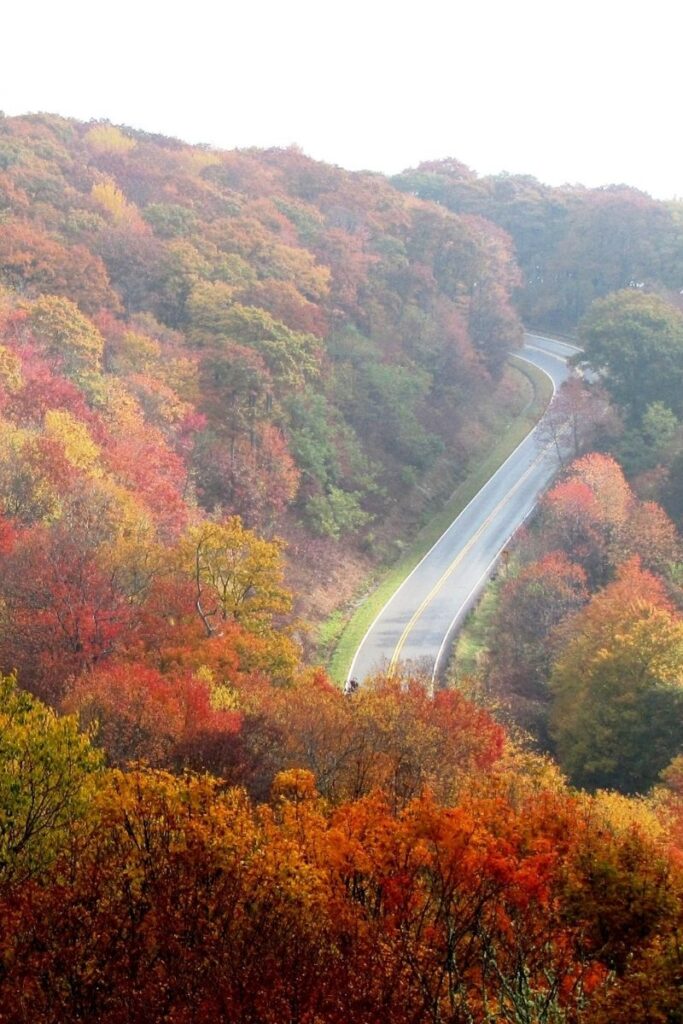
National Parks in North Carolina: Explore the 10 North Carolina National Parks (2022 Update)
- Jennifer Melroy
- Last Modified February 12, 2022
- First Published on November 29, 2019








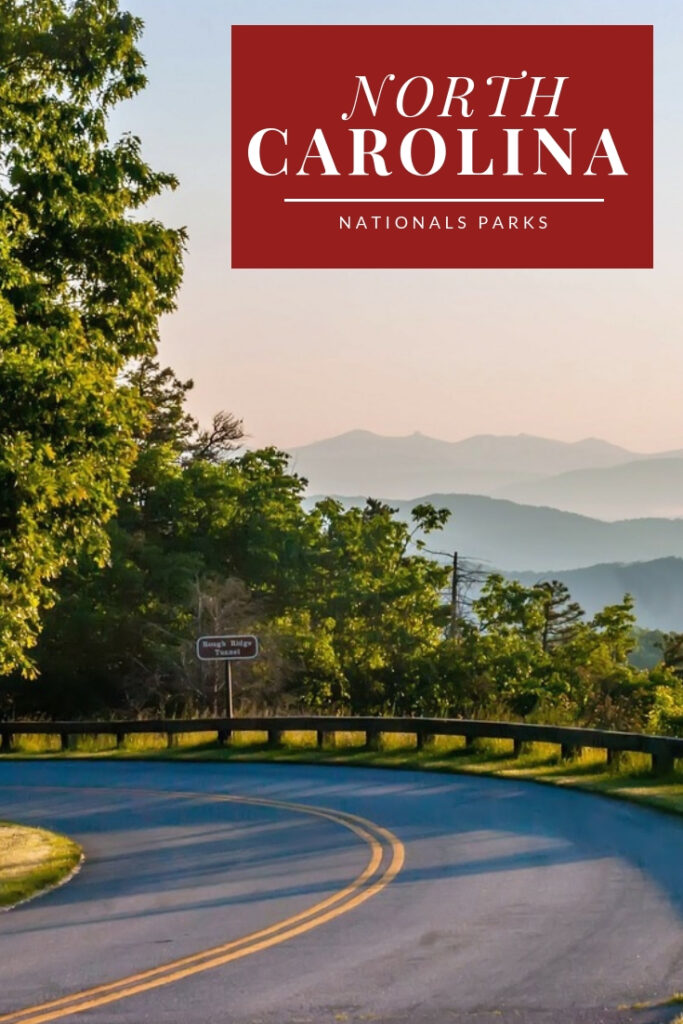






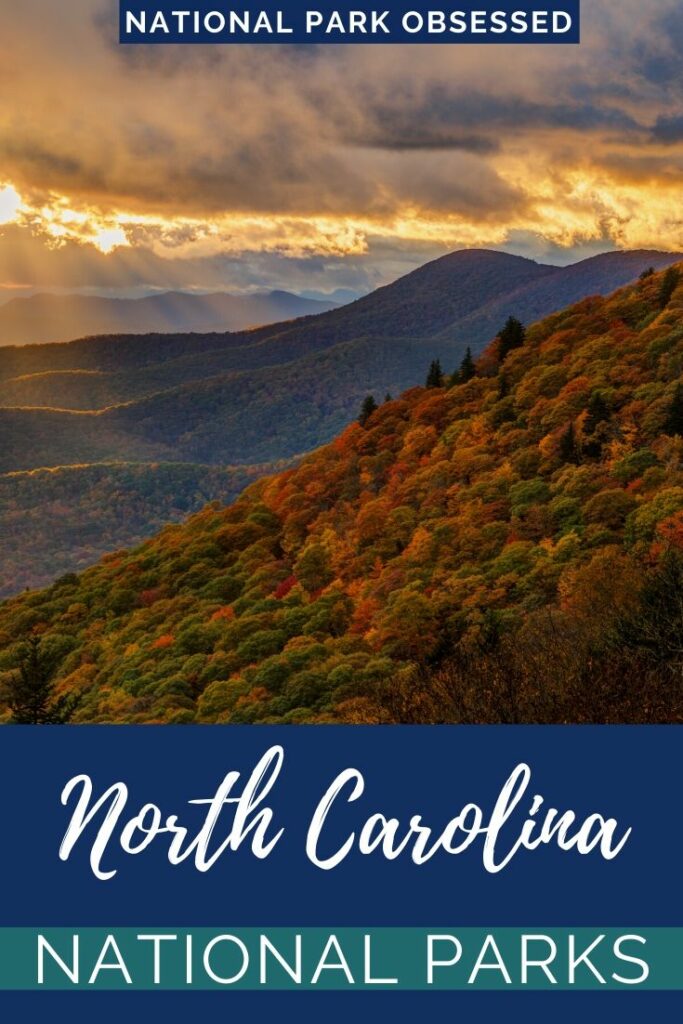

Post summary: National Parks in North Carolina
North Carolina is a is a southeastern state with a wide range of landscapes ranges from the Appalachian Mountains to the Atlantic coastal plans. The state is home to Mt. Mtichell at 6,684 ft (2,037 m) which is the the highest point in the US east of the Mississippi River. The state has a rich human history dating back to over 10,000 years and is the ancestral homeland of many Native peoples such as the Carolina Algonquian and Iroquoia peoples.
In this article, we will explore the 10 National Parks in North Carolina. We will provide a brief overview of the park, things to do in the North Carolina National Parks, and provide a map of the National Parks of North Carolina.
This post may contain affiliate links, meaning if you book or buy something through one of these links, I may earn a small commission at no extra cost to you! Read the full disclosure policy here
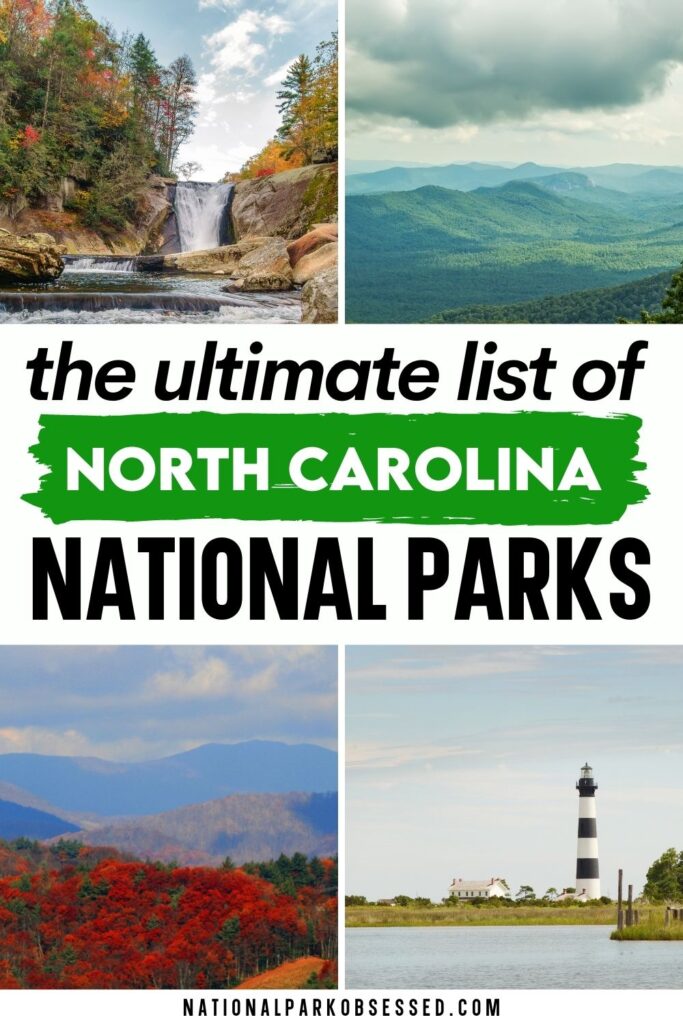
Map of National Parks in North Carolina
Fun Facts about North Carolina
- North Carolina is part of the Southeast Region.
North Carolina National Parks
Appalachian National Scenic Trail
Depending on where you are from, the Appalachian National Scenic Trail either starts in Mount Katahdin, Maine and ends in Springer Mountain, Georgia, or starts in Springer Mountain, Georgia, and ends in Katahdin, Maine. The Appalachian Trail is 2,181 miles long and passes through 14 states (Georgia, North Carolina, Tennessee, Virginia, West Virginia, Maryland, Pennsylvania, New Jersey, New York, Connecticut, Massachusetts, Vermont, New Hampshire, and Maine).
There are 95.7 miles of trail in the state of North Carolina and about 200 miles that run along the Tennessee/North Carolina border. The trail enters North Carolina at Bly Gap and hikers will climb Standing Indian Mount, Mt. Albert, and Wayah Bald. At Fontana Dam, the trail enters the Great Smoky Mountains National Park.
Every year several thousand people attempt to thru-hike the trail. Tens of thousands of people will hike sections of the trail each year. The trail was officially completed in 1937 but the improvement has been ongoing since then. The trail is maintained by 31 different trail clubs and other partnerships.
Things to do: Hiking, Wildlife Viewing, Scenic Views
How to get there: There are multiple access points along the trail. Many of which are driveable.
Where to Stay: Along the trail, there are numerous shelters and backcountry campgrounds. Hotels are available in towns along the trail.
Entrance Fee: There is no entrance fee for the Appalachian Trail but the trail passes through numerous state and national parks, forests, and public lands which may charge an entrance fee or have overnight permit fees.
Official Website: Click Here
Map: Download

Blue Ridge Parkway
For 469 miles, the Blue Ridge Parkway winds its way high country of the Eastern Appalachians of North Carolina and Virginia. The Parkway links Shenandoah National Park with Great Smoky Mountain National Park. These two parks and parkways are the busiest in the park system. The parkway holds the title of the busiest National Park Service site.
The Blue Ridge Parkway was the longest road planned as a single unit. Construction started in 1935 and was delayed by World War II. The road wasn’t officially finished until 1987. The northern terminus is located in Rockfish Gap, Virginia and the southern terminus is in Cherokee, North Carolina.
Visitors are welcome to drive as much or as little as the parkway as they would like. The speed limit is 45 miles an hour and there are pullouts to stop and enjoy the view. There are many hiking trails found along the Blue Ridge Parkway.
The Blue Ridge Park was established on September 11, 1935, when construction began as a Civilian Conservation Corps.
Things to do: auto touring, bicycling, fishing, hiking
How to get there: The Blue Ridge Parkway runs from Cherokee, NC to Wayneboro, VA. There are numerous on and off points between the two locations.
Where to Stay: There are several campgrounds along the parkway and hotels are located near most the on-off points.
Entrance Fee: Free
Official Website: Click Here
Map: Download

Cape Hatteras National Seashore
Cape Hatteras National Seashore protects 70 miles of unspoiled Outer Banks shoreline. The seashore protects three of the barrier islands – Bodie, Hatteras, and Ocracoke. The area is an important winter habitat for many species of waterfowl such as tundra swans. Five species of sea turtles can be found in the area. These include leatherback, hawksbill, Kemp’s ridley, loggerhead, and green.
Visitors come to Cape Hatteras to spend time on the beach, explore the historic lighthouses. The famed Cape Hatteras Lighthouse was moved over 2,900 ft to save it from eroding into the sea. The region offers some of the best surfing on the east coast. Hikers have plenty of trails to explore and birders come to see the range of waterfowl.
Cape Hatteras National Seashore was established on January 12, 1953. The site is the first of the protected seashores in the United States.
Things to do: Hiking, Lighthouse Climbing, Fishing, Hunting, Beach Walking, Off-road driving, Kite Flying
How to get there: Cape Hatteras can be reached via Route 168 and US-158.
Where to Stay: Camping is available in the park and there are hotels and rental through the Outer Banks.
Entrance Fee: Free
Official Website: Click Here
Map: Download
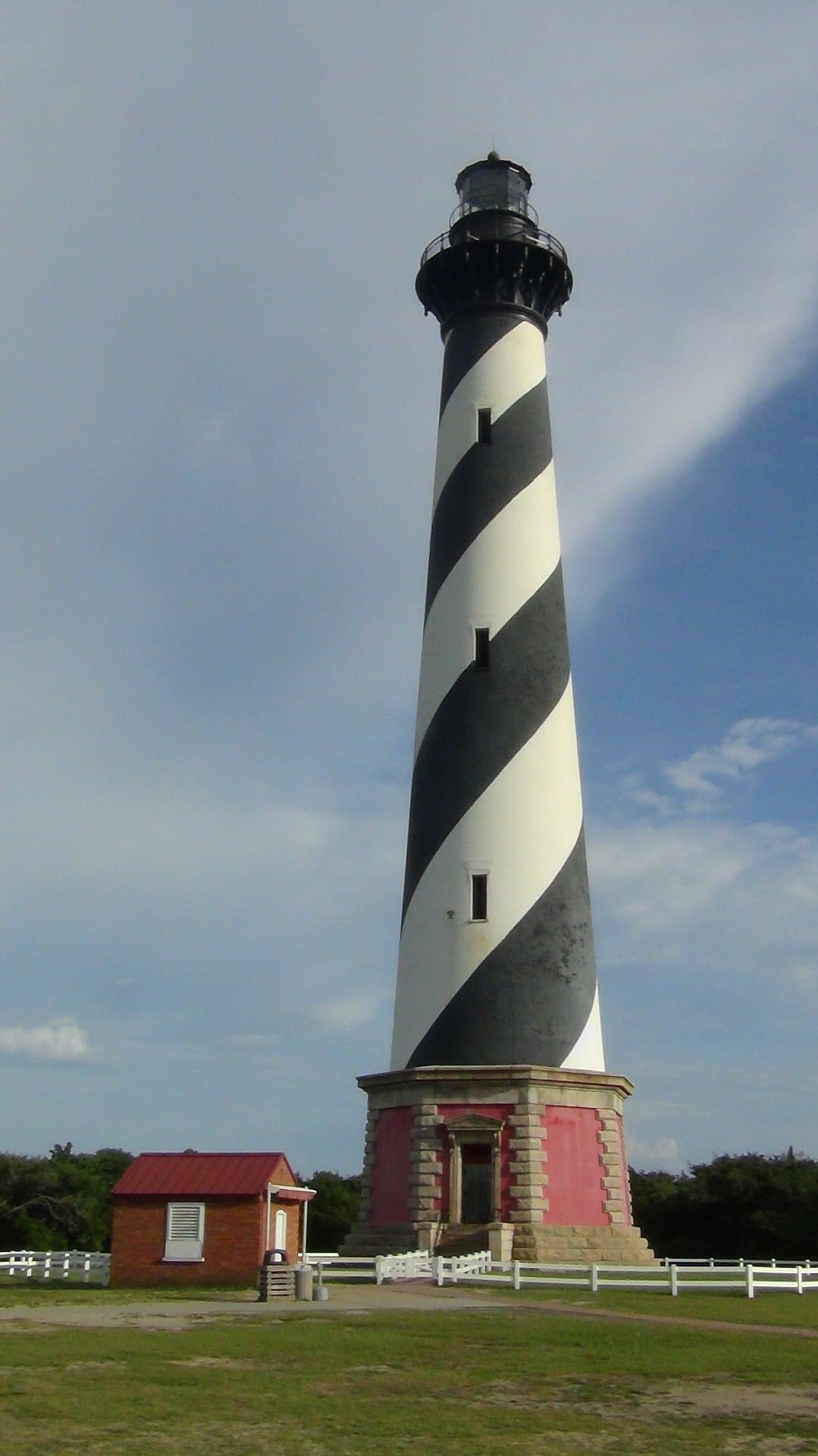
Cape Lookout National Seashore
Cape Lookout National Seashore is a 56-mile long section of the southern Outer Banks. This section is south of Cape Hatteras. These outer islands are only accessible via boat. Ferries are available to reach the islands of North Core Banks, South Core Banks, and Shackleford Banks.
Visitors need to be prepared to visit Cape Lookout. The islands are not developed and services are incredibly limited. Camping is allowed almost everywhere but trash cans, bathhouses, and freshwater are non-existent. Visitors come to view the wild horses on Shackleford Banks. During the summer, tours are offered of the historic Cape Lookout Lighthouse and Portsmouth Village.
Cape Lookout National Seashore was established on March 10, 1966.
Things to do: Fishing, Camping, Birding, Beach Driving, Wildlife Watching, Star Gazing, Lighthouse viewing.
How to get there: Cape Lookout is only accessible via ferry.
Where to Stay: You can beach camp at Cape Lookout or stay at the rustic cabins.
Entrance Fee: Free, but you will have to pay for the ferry to get out.
Official Website: Click Here
Map: Download

Carl Sandburg Home National Historic Site
Carl Sandburg Home National Historic Site protects Connemara. Connemara was the home of Pulitzer Prize-winning poet and writer Carl Sandburg along with his wife Lilian. Carl Sandburg is a famed American poet and writer. He won three Pulitzer Prizes and a Robert Frost Medal. His first Pulitzer Prize in 1919 for his poems Cornhuskers. He won his second Pulitzer Prize in 1940 for his Abraham Lincon Biography – Abraham Lincoln: The War Years. His third Pulitzer in 1950 for his Complete Poems. The couple bought the home in 1945 so Sandburg could write in peace and his wife could raise champion dairy goats.
Visitors to the Carl Sandburg Home can take a guided tour of the house and explore many of Sandburg’s personal items and an extensive library. National Park Service maintains a small herd of dairy goats. During the summer, the park offers milking and cheese-making demonstrations.
Sandburg Home National Historic Site has created a national historic site on October 17, 1968.
Things to do: Home tour, goat petting, hiking
How to get there: The home is located on Rt. 225 in Flat Rock, NC. It can be reached from I-26, I-40, I-240, and I-85.
Where to Stay: There are hotels options in Hendersonville, NC. The site can also be day tripped from Greenville, SC or Asheville, NC.
Entrance Fee: Free, house tours cost $10 per person.
Official Website: Click Here
Map: Download

Fort Raleigh National Historic Site
Fort Raleigh National Historic Site preserves the location of the first English settlement in the United States. This settlement was known as the Roanoke Colony. It was founded in July 1587 by John White and sponsored by Sir Walter Raleigh. White’s granddaughter was born in the colony in August 1587. She was the first English child born in the New World. In late 1587, White returned to England to resupply the colony. Due to war in Europe, White did not return until August 1590. White found the colony abandoned and the word “CROATOAN” carved into a tree. Croatoan is a Native American tribe native to the region. To this day, what actually happened to the Roanoke Colony remains a mystery.
Today, visitors can explore the area and view some exhibitions and video presentations. There is a 1.25-mile hiking trail. Fort Raleigh National Historic Site was established on October 15, 1966.
Things to do: Historical Tours, Fishing
How to get there: The fort is located on the north end of Roanoke Island. It can be reached by I-64, I-664, and I-95.
Where to Stay: There are lodging options in Manteo, NC.
Entrance Fee: Free
Official Website: Click Here
Map: Download

Great Smoky Mountains National Park
Great Smoky Mountains National Park is one of the iconic national parks of the United States. Straddling the borders of Tennessee and North Carolina, this national park is consistently the busiest national park. The park protects the Great Smoky Mountains region of the Blue Ridge Mountains. The site is a UNESCO World Heritage Site and International Biosphere Reserve. The Smokies has vast biodiversity. Over 12,000 species have been found in the park.
Visitors to Great Smoky Mountains National Park have over 900 miles of hiking trails to explore along with several historical sites. The Cades Cove loop visits many historic log cabins and gristmill and showcases early pioneer and rural history. The park has a range of wildlife such as white-tailed deer and black bears. Elk has been reinforced and the population is growing.
Great Smoky Mountains National Park was established on June 15, 1934, with the help of John D. Rockefeller, Jr and local citizens who assemble the land for the park, piece by piece. The park became an International Biosphere Reserve in 1976. It was declared a UNESCO World Heritage Site in 1983.
Things to do: Auto Touring, Bicycling, Burial Landscapes, Camping, Fall Colors, Fishing, Hiking, Historic Buildings ,Horseback Riding, Picnicking, Ranger-led Programs, Waterfalls, Wildflowers and Blooming Shrubs, Wildlife Viewing,
How to get there: Lodging can be found in the gateway towns such as Gatlinburg, Townsend or Cherokee.
Where to Stay: Lodging can be found in the gateway towns such as Gatlinburg, Townsend or Cherokee.
Related: Best Airbnbs in Great Smoky Mountains National Park
Entrance Fee: Free
Official Website: Click Here
Map: Download

Guilford Courthouse National Military Park
Guilford Courthouse National Military Park commemorates the Battle of Guilford Courthouse. The Battle of Guilford Courthouse took place on March 15, 1781. British Lieutenant-General Charles Cornwallis defeated Colonial Army lead by Major General Nathanael Greene. The British won a tactical victory but suffered extremely heavy losses.
It might seem a little odd that the United States has chosen to protect a battlefield where we were defeated but Gilford Courthouse is considered to be the beginning of the end of the Revolutionary War. Greene’s army escaped south where they retook the future states of South Carolina and Georgia. Cornwallis would march on to Virginia where he would be defeated in Yorktown.
Visitors to Guilford Courthouse National Military Park are able to take a self-guided auto or bicycle tour of the park. The park offers several hiking trails and monuments to the battle.
Guilford Courthouse National Military Park was established as a military park on March 2, 1917.
Things to do: Auto Touring, Walking Tours, Bicycling, Historic Tours,
How to get there: The Park is located near I-85 and I-40.
Where to Stay: There are plenty of lodging options in Greensboro, NC.
Entrance Fee: Free
Official Website: Click Here
Map: Download

Moores Creek National Battlefield
Moores Creek National Battlefield commemorates the Battle of Moore’s Creek Bridge. On February 27, 1776, about 1,000 North Carolina Patriots skirmished against about 800 North Carolina Loyalists. North Carolina’s royal governor Josiah Martin was raising an army to assist with the planned landing of an invasionary force. The Patriots victory ended the North Carolina invasion plan until 1780.
Visitors can walk a 1-mile trail with exhibits on the battlefield.
Moores Creek National Battlefield was established on June 2, 1926, as Moores Creek National Military Park. It was changed to Moores Creek National Battlefield in September 8, 1980.
Things to do: Historical Tours, Walking, Bark Ranger
How to get there: The Battlefield is located near I-40
Where to Stay: Lodging can be found in nearby towns of Burgaw.
Entrance Fee: Free
Official Website: Click Here
Map: Download

Wright Brothers National Memorial
Wright Brothers National Memorial commemorates the first successful, powered flight. The Wright brothers successfully designed, built and fly the first airplane. Orville and Wilbur Wright moved from Ohio to North Carolina for this project. They selected Kill Devil Hills, North Carolina due to the steady winds and remote location.
Visitors are welcome to explore the visitor center museum. The museum contains many of the original tools and reproduction of their wind tunnel, models and a life-size replica of the 1903 Flyer. The original 1903 Flyer is located in the National Air and Space Museum in Washington DC. Along the field, there are several monuments to mark the start and end of the first four successful flights. On the summit of Kill Devil Hill, there is a monument tower to celebrate the Wright Brothers’ achievement.
Wright Brothers National Memorial was established on March 2, 1927, as Kill Devil Hill Monument. It was created a National Memorial on August 10, 1933.
Things to do: Historic Tour, Walking
How to get there: The park is located just off US-158
Where to Stay: Kitty Hawk has a few hotel options.
Entrance Fee: $10 per person or free with an America the Beautiful Pass.
Official Website: Click Here
Map: Download
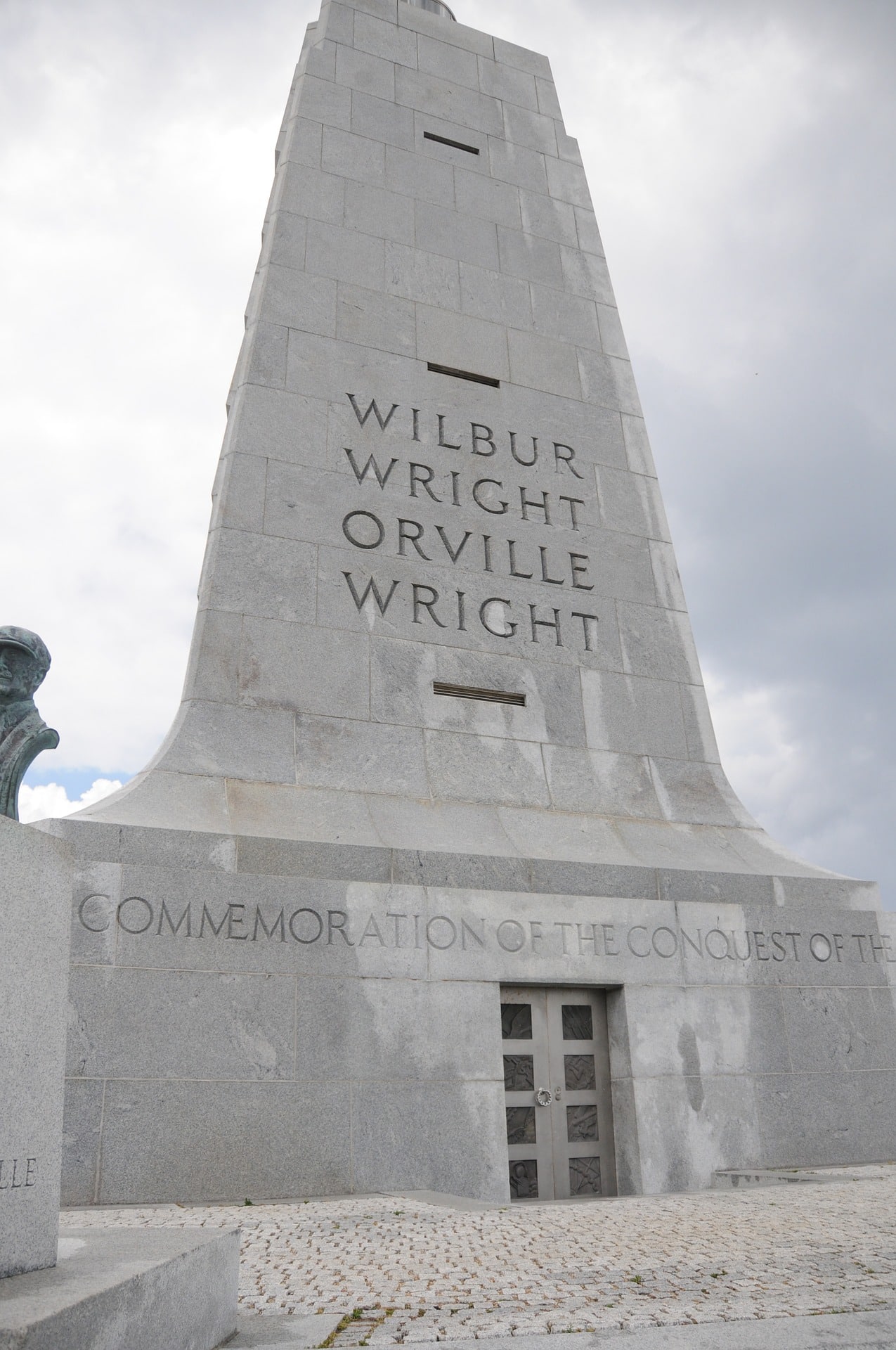
Affiliate Sites of North Carolina
Blue Ridge National Heritage Area
The Blue Ridge National Heritage Area comprises of the twenty-five western counties of North Carolina. All of these counties include a section of the Blue Ridge Mountains. The area includes portions of the Great Smoky Mountains National Park, the Blue Ridge Parkway, and the Appalachian Trail. It includes the Pisgah National Forest and Nantahala National Forest.
Visitors are welcome to explore the areas National Park Service sites as well as the National Forests. The region has a rich musical and folk art heritage.
The Blue Ridge National Heritage Area includes Alleghany, Ashe, Avery, Buncombe, Burke, Caldwell, Cherokee, Clay, Graham, Haywood, Henderson, Jackson, McDowell, Macon, Madison, Mitchell, Polk, Rutherford, Surry, Swain, Transylvania, Watauga, Wilkes, Yadkin and Yancey counties. Blue Ridge National Heritage Area was established on November 10, 2003.
Things to do: Hiking, Fishing, Fall Foliage, Camping, Farmers’ Markets, Festivals, Swimming, Canoeing, Kayaking, Biscyling, Mountain Biking
How to get there: The region has several major airports such as Charlotte and Asheville.
Where to Stay: Lodging can be found throughout the region.
Entrance Fee: Free but attractions within the area may charge fees.
Official Website: Click Here

Gullah/Geechee Cultural Heritage Corridor
The Gullah/Geechee Cultural Heritage Corridor covers the Atlantic coastal region of Florida, Georgia, North Carolina, and South Carolina. The area focuses on protecting the Gullah-Geechee people and culture. The Gullah-Geechee people are descended from West African slaves forced to work in the cotton fields, rice paddies, and indigo plantations.
Visitors can explore the unique culture thru several museums, historical churches and schoolhouses and the remains of plantations. There are 79 Atlantic barrier islands in the area. Charles Pinckney National Historic Site is located in the region.
Gullah/Geechee Cultural Heritage Corridor was created in October 12, 2006.
Things to do: Historical Tours, Hiking, Fishing,
How to get there: The area is accessible form I-95 and popular airports in the region include Charleston, Savannah, and Jacksonville.
Where to Stay: Lodging can be found throughout the region.
Entrance Fee: Free but attractions within the area may charge fees.
Official Website: Click Here
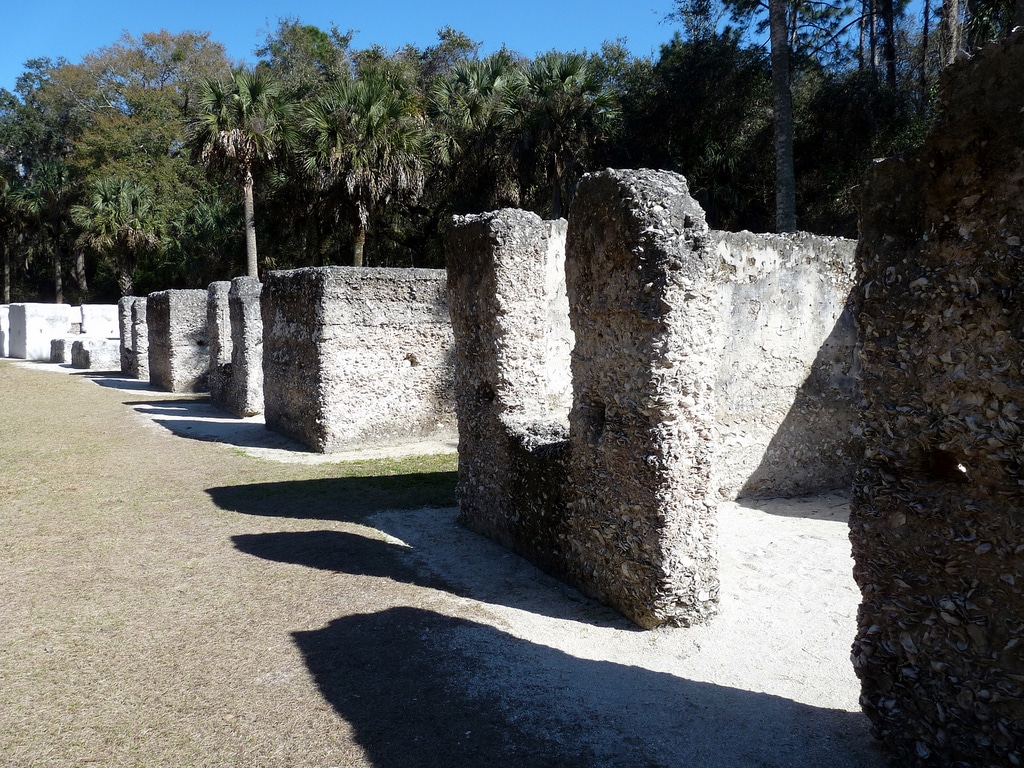
Overmountain Victory National Historic Trail
The Overmountain Victory National Historic Trail is primarily an auto trail through Virginia, Tennessee, North Carolina, and South Carolina. The trail is operated in a cooperative effort by the U.S. Forest Service, U.S Army Corps of Engineers, National Park Service, and local efforts. The trail is a 330-mile corridor. The trail follows the route American patriots traveled during the Revolutionary War to the Battle of King’s Mountain.
These men hike and road from all over the Appalachian mountains to join the militia and fight for American’s independence. Today the trail is 330 miles long and follows many of the original roads used by the men marching. Important sites along the trail include the Fort Watauga Monument, Dunn’s Meadow, Roaring Creek, and Bedford’s Hill.
Overmountain Victory National Historic Trail was created in September 1980.
Things to do: Historical Tours, Hiking, Auto Tours
How to get there: The trail is accessible form I-40.
Where to Stay: Lodging can be found along the trail.
Entrance Fee: Free, but attractions along the trail may charge an entrance fee.
Official Website: Click Here
Map: Download

Trail of Tears National Historic Trail
The Trail of Tears National Historic Trail follows the different routes members of the Cherokee, Muscogee (Creek), Seminole, Chickasaw, Choctaw, Ponca, and Ho-Chunk/Winnebago nations were forced to march for resettlement as part of the Indian Removal Act. The Trail of Tears follows the four main routes from Tennessee, North Carolina, and Georgia through Kentucky, Illinois, Missouri, Alabama, Mississippi, Arkansas on their way to Oklahoma.
The Trail of Tears National Historic Trail stands as a reminder of the horrific treatment the American Indians suffered at the hands of the U.S government. It is estimated between 2,000 – 8,000 Cherokee died along the trail (that doesn’t include deaths of any of the other tribes or deaths in the Seminole wats).
Today, visitors to the Trail of Tears can drive any one of the four main autoroutes and visit sites such as the Cherokee County Historical Museum, Brainerd Mission Cemetery, Cherokee National Museum, and Fort Payne Cabin Site to learn more about the journey the American Indians were forced to make and the challenges they faced.
Trail of Tears National Historic Trail was created in 1987.
Things to do: Historical Sites, Museums, auto touring, walking
How to get there: The trail follows several routes as it pass through Tennessee, North Carolina, and Georgia through Kentucky, Illinois, Missouri, Alabama, Mississippi, Arkansas and Oklahoma
Where to Stay: There is no lodging on the trail itself, but multiple options are located along the route the trail.
Entrance Fee: Free
Official Website: Click Here
Map: Download
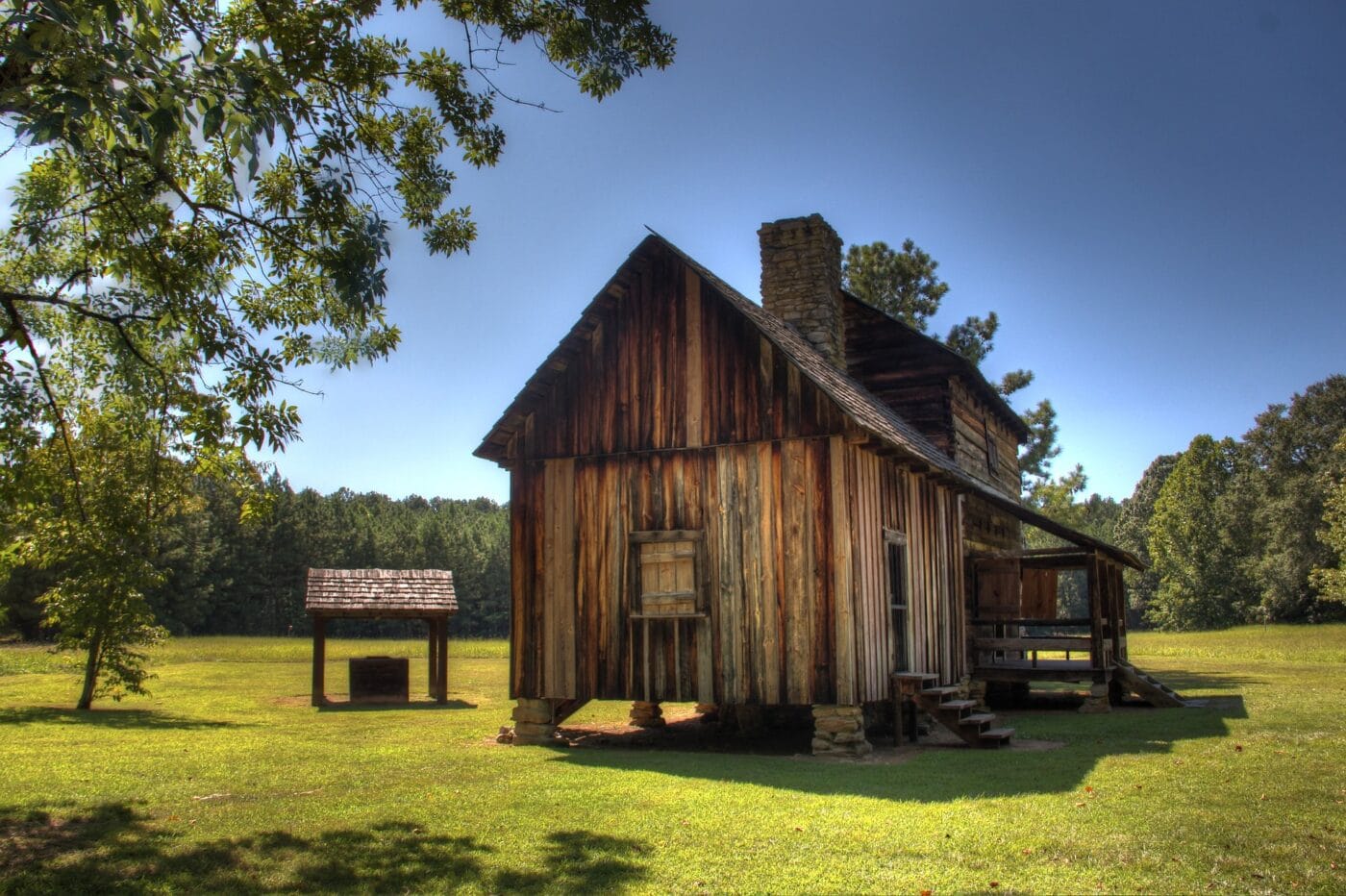
List of National Parks in North Carolina
There are 8 National Parks in North Carolina and they received 17.9 million visitors in 2020 and generated over 1.967 billion dollars in tourism economic benefits. The majority of visitors (14 million) visited the Great Smoky Mountains National Park and Blue Ridge Parkway.
- Appalachian National Scenic Trail (CT, GA, MA, MD, ME, NC, NH, NJ, NY, PA, TN, VA, VT, WV)
- Blue Ridge Parkway (VA, NC)
- Cape Hatteras National Seashore
- Cape Lookout National Seashore
- Carl Sandburg Home National Historic Site
- Fort Raleigh National Historic Site
- Great Smoky Mountains National Park (NC, TN)
- Guilford Courthouse National Military Park
- Moores Creek National Battlefield
- Wright Brothers National Memorial
Affiliated Areas
- Blue Ridge National Heritage Area
- Gullah/Geechee Cultural Heritage Corridor (FL, GA, NC, SC)
- Overmountain Victory National Historic Trail (NC, SC, TN, VA)
- Trail of Tears National Historic Trail (AL, AR, GA, IL, KY, MO, NC, OK, TN)
North Carolina National Parks also provides support and management to an additional National Heritage Area, 2 Wild & Scenic Rivers as well as 3,051 National Register of Historic Places Listings.
There are 39 National Historic Landmarks, 13 National Natural Landmarks, 585 Places recorded by the Heritage Documentation Program, and over 2.75 million objects in the North Carolina National Parks Museum Collections. There are 630 Archaeological Sites in the North Carolina National Parks.
North Carolina is home to 41 State Parks.
North Carolina UNESCO World Heritage Sites
- Great Smoky Mountains National Park
Frequently Asked Questions about North Carolina National Parks
How many national parks are in North Carolina?
There are 10 National Parks in North Carolina and 4 associated sites. The 10 NPS units are Appalachian National Scenic Trail, Blue Ridge Parkway, Cape Hatteras National Seashore, Cape Lookout National Seashore, Carl Sandburg Home National Historic Site, Fort Raleigh National Historic Site, Great Smoky Mountains National Park, Guilford Courthouse National Military Park, Moores Creek National Battlefield, and Wright Brothers National Memorial. The associated sites are Blue Ridge National Heritage Area, Gullah/Geechee Cultural Heritage Corridor, Overmountain Victory National Historic Trail, and Trail of Tears National Historic Trail.
What are the 10 national parks in North Carolina?
The 10 national park of North Carolina are Appalachian National Scenic Trail, Blue Ridge Parkway, Cape Hatteras National Seashore, Cape Lookout National Seashore, Carl Sandburg Home National Historic Site, Fort Raleigh National Historic Site, Great Smoky Mountains National Park, Guilford Courthouse National Military Park, Moores Creek National Battlefield, and Wright Brothers National Memorial.
What is the most visited national park in North Carolina?
The most visited national park in North Carolina is the Blue Ridge Parway. About 8.7 million people visited the parkway in 2020. Great Smoky Mountains National Parks come in second with 5.3 million.
What is the best national park in North Carolina?
Depends on your preference. I love Great Smoky Mountains National Park but other parks like Cape Lookout or Cape Hatteras are cool too.
What is the largest national park in NC?
Great Smoky Mountains National Park is the largest park in North Carolina even accounting for the fact that half of the Smokies is in Tennessee.
Is Biltmore a national park?
No, the Biltmore is not a national park. It is still owned by the family of William Amherst Vanderbilt Cecil. While this Vanderbuilt mansion isn’t a national park. Of the MANY Vanderbuilt mansions, only the Hyde Park Mansion in update New York is a national park. It is known as the Vanderbilt Mansion National Historic Site.
Other Vanderbilt Mansion you can tour beyond the Biltmore and Hyde Park include
- The Breakers – Newport, Rhode Island
- Marble House – Newport, Rhode Island
- Eagle’s Nest – Centerport, New York
North Carolina’s Neighboring States
Planning to visit a few of the National Parks in North Carolina and wondering about what national parks are in neighboring states. Here are the list of National Parks in surrounding states.
- Georgia National Parks – Gerogia has 11 NPS units.
- South Carolina National Parks – South Carolina is home to Congaree National Park and 6 other units.
- Tennessee National Parks – Tennesse shares Great Smoky Mountains National Park with North Carolina and has 12 other units.
- Virginia National Parks – Virginia has Shenandoah National Park and 21 NPS units.
Final Thoughts on the National Parks of North Carolina
I hope this guide to the National Parks of North Carolina is helpful as you plan to explore these amazing National Parks. Do you have any questions about the National Parks in North Carolina or need help planning your National Park trips. Let me know in the comments below or join me in my National Park Trip Planning Community!
Pin for Later: National Parks in North Carolina: Explore the 10 North Carolina National Parks (2022 Update)

Jennifer Melroy
Hi, I'm Jennifer!
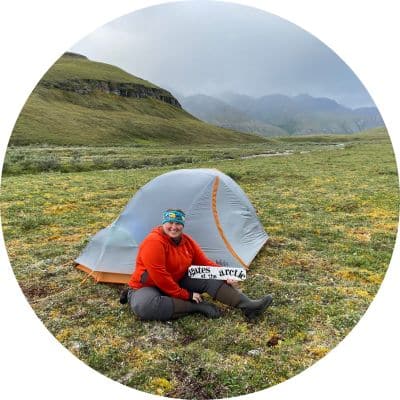
Welcome to the wonderful world of National Parks. I'm here to help you plan your NEXT amazing adventure through the United States National Parks and beyond. I want the national parks to be accessible to all.
I live in Tennessee, and when I'm home, you can find me hiking in the Smokies and the Cumberland Plateau.
58/63 National Parks
250+/423 National Park Units
Want to know more? Start Here.
Explore More
ACKNOWLEDGEMENT OF LAND
On this site, we promote travel to the United States and beyond that are the traditional lands of Indigenous and First Nations peoples.
With respect, I make a formal land acknowledgment, extending my appreciation and respect to these lands’ past and present people.
To learn more about the people who call these lands home, I invite you to explore Native Land.
DISCLAIMER
National Park Obsessed assumes no responsibility or liability for any errors or omissions in the content of this site (NationalParkObsessed.com). The information contained in this site is provided with no guarantees of completeness, accuracy, usefulness or timeliness. You are encouraged to conduct your own due diligence before acting on the information provided on this site and should not rely on the opinions expressed here.
There is an inherent risk in all outdoor recreation activities, the reader assumes all responsibility for their own personal safety.
DISCLOSURE
We are a participant in the Amazon Services LLC Associates Program, an affiliate program designed to provide a means for us to earn fees by linking to Amazon.com and affiliated sites.
Privacy Policy • About Us • Contact
Select stock photography provided depositphotos
Copyright ©2023 National Park Obsessed, LLC
Privacy Overview
Last Updated on 12 Feb 2022 by Jennifer Melroy



